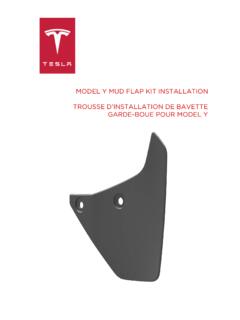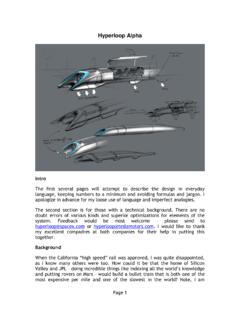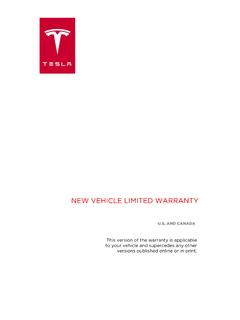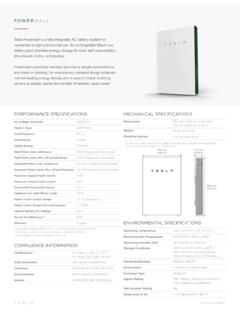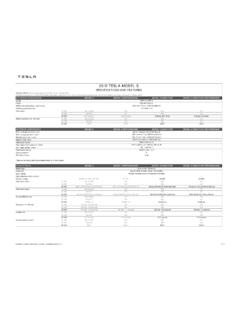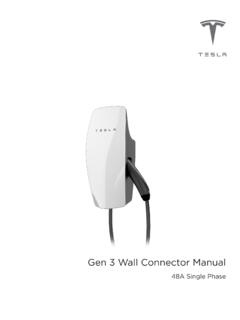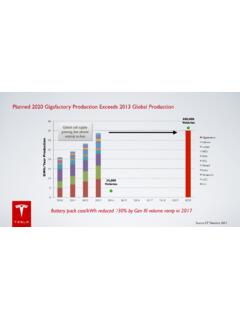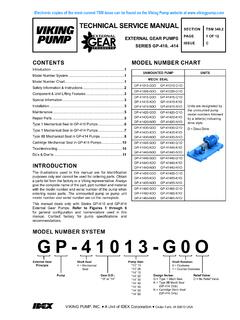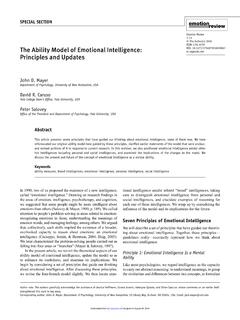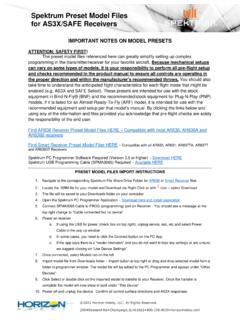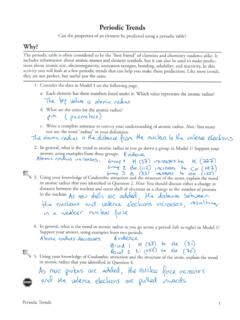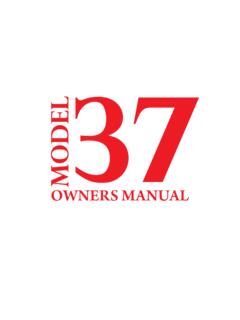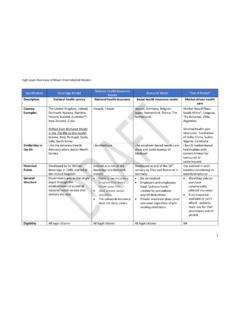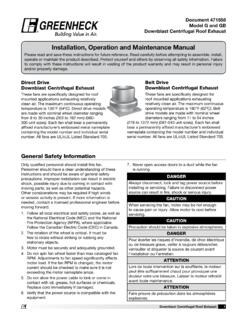Transcription of INFORMATION FOR FIRST AND SECOND RESPONDERS …
1 INFORMATION FOR FIRST AND SECOND RESPONDERS EMERGENCY RESPONSE GUIDETESLA model 3 ELECTRICVERSION: 0011. Identification / recognition2. Immobilization / stabilization / liftingCONTENTS3. Disable direct hazards / safety regulations4. Access to the occupants5. Stored energy / liquids / gases / solids6. In case of fire7. In case of submersion8. Towing / transportation / storage9. Important additional information10. Explanation pictograms used0. Emergency Response SheetPage 1 Page 2 Page 5 Page 7 Page 13 Page 20 Page 23 Page 25 Page 26 Page 28 Page 29 model 3 Emergency Response GuideID 202012 0030101/04 TESLA model 3 From 2020 PresentTESLA model 3 From 2020 PresentAirbagStored gas inflatorSeatbelt preten-sionerSRS Con-trol UnitPedestrian protection active systemAutomatic rollover protection systemGas strut/pre-loaded springHigh strength zoneZone requiring special attentionBattery low volt-ageUltra ca-pacitor, low voltageFuel tankGas tankSafety valveHigh voltage battery packHigh volt-age power cable/com-ponentHigh voltage discon-nectFuse box disabling high voltage systemUltra capaci-tor, high voltageCable cut2 model 3 Emergency Response Guide1.
2 Identification / recognitionBadging and Door HandlesModel 3 can be identified by its badges and uniquely shaped door handles. The model name appears on the rear of the OF ENGINE NOISE DOES NOT MEAN VEHICLE IS OFF. SILENT MOVEMENT OR INSTANT RESTART CAPABILITY EXISTS UNTIL VEHICLE IS FULLY SHUT DOWN. WEAR APPROPRIATE PERSONAL PROTECTIVE EQUIPMENT (PPE).WARNINGNOTE: model 3 may have a DUAL MOTOR badge on the trunk to indicate that it is a dual motor :The Tesla emblem indicates a fully electric Identification Number (VIN) model 3 can be identified by its VIN. locate the stamped plate on the top of the dashboard by looking through the driver s side of the windshield. model 3 is identified with a 3 in the 4th alphanumeric position. The VIN can also be found on the driver s side door pillar, and on some vehicles, under the carpet behind the passenger 3 Emergency Response GuideTouchscreenModel 3 can be identified by its 15 in (38 cm) touchscreen that is mounted in a landscape orientation.
3 model 3 does not have an instrument cluster in front of the steering to the Owner s Manual for INFORMATION on touchscreen operation. If vehicle airbags have deployed, 12V power may not be available and the touchscreen will not be operational. Trying to support 12V power on a vehicle that has been in an accident could lead to a possible 12V electrical fire. Tesla does not recommend attempting to reconnect 12V power. 4 model 3 Emergency Response Guide Tap the model 3 key card on the driver s side door pillar to unlock or lock the vehicle, and once more on the center console to enable driving key fob is shaped like a miniature model 3. It allows you to press buttons to open the front and rear trunks and unlock, lock, and drive model 3. Use the key buttons as shown 3 supports 3 types of personal smartphone can be set up to communicate with model 3 using Bluetooth. If a smartphone is already paired to the vehicle, open the Tesla mobile app on the smartphone and navigate to CONTROLS to unlock or lock model 3.
4 Authenticated phone Key fob 1. Front trunk - Double-click to open the front Lock/Unlock All - Single-click to lock doors and trunks (all doors and trunks must be closed). Double-click to unlock doors and Rear trunk lid - Double-click to open the rear trunk lid. Hold down for one to two seconds to open the charge port door. Key card 5 model 3 Emergency Response Guide2. Immobilization / stabilization / liftingIMMOBILIZATION1. Chock wheelsModel 3 moves silently, so never assume it is powered off. Drivers can choose a setting that determines whether or not model 3 will creep when a drive gear is selected. If this setting is off, model 3 may not move unless the accelerator pedal is pressed, even if shifted into Drive or Reverse. However, never assume that model 3 will not move. Always chock the careful to not damage the battery pack while stabilizing the Put vehicle into Park positionModel 3 moves silently, so never assume it is powered off. Pressing the accelerator pedal even slightly can cause model 3 to accelerate quickly if the active gear is Drive or Reverse.
5 To ensure that the parking brake is engaged, press the button on the end of the gear selector to shift into Park. Whenever model 3 is in Park, the parking brake is automatically engaged and the touchscreen shows the active gear as Park (P).6 model 3 Emergency Response GuideSTABILIZATION / LIFTING POINTSThe high voltage battery is located under the floor pan. A large section of the undercarriage houses the high voltage battery. When lifting or stabilizing model 3, only use the designated lift areas, as shown in careful to not damage the battery pack while stabilizing / lifting the vehicle should be lifted or manipulated only if FIRST RESPONDERS are trained and equipped at the technician level per National Fire Protection Association (NFPA) and are familiar with the vehicle s lifting points. Use caution to ensure you never come into contact with the high voltage battery or other high voltage components while lifting or manipulating the NOT USE THE HIGH VOLTAGE BATTERY TO LIFT OR STABILIZE model lift areasSafe stabilization points for a model 3 resting on its sideHigh voltage battery7 model 3 Emergency Response Guide3.
6 Disable direct hazards / safety regulationsACCESS1. Open the hood (see chapter 4: Access to the Occupants).2. Remove the access panel by pulling it upward to release the clips that hold it in DISABLE METHOD1. Double cut the FIRST responder loop and then remove the cut Disable the 12V every high voltage component is labeled. Always wear appropriate PPE. Always double cut the FIRST responder loop. Do not attempt to open the High Voltage (HV) 3 Emergency Response GuideSECONDARY DISABLE METHOD1. locate the approximate location of the secondary FIRST responder cut Gain access to the interior trim panel by breaking or removing the rear fixed Peel away the trim panel and double cut the FIRST responder loop then remove the cut :The secondary cut loop is is located on the right side of model 3 under the rear trim panel next to the rear fixed every high voltage component is labeled. Always wear appropriate PPE. Always double cut the FIRST responder loop. Do not attempt to open the High Voltage (HV) 3 Emergency Response GuideCable CutWhen cut, the FIRST Responder Loop disables 12V power going to the airbag circuit.
7 Cutting of the FIRST Responder Loop also removes 12V power going to the high voltage contactors inside the high voltage battery pack. Cutting the FIRST responder loop does not disable the 12V battery system. The 12V battery negative cable must be cut in order to disable the 12V battery FIRST Responder Loop is located on the passenger-side of the vehicle for left-hand drive vehicles. The FIRST Responder Loop remains in the same location for right-hand drive high voltage contactors are like a light switch. When open or in the off position, the lights would be off in the room so the high voltage would be isolated to the battery pack. When closed or in the on position, the lights would be on in the room so the high voltage in the battery pack would be connected to the high voltage components. On model 3 vehicles, those high voltage components include the rear drive unit, the front drive unit, the air conditioning compressor, the coolant heater, the cabin postive temperature coefficient (PTC) heater, and the rear PTC the vehicle has been in an accident and the FIRST Responder Loop has been cut, always treat the pack and the high voltage components as if they are live, because the pack will still have stored energy within the cells and it is not known if other high voltage components have been damaged.
8 Treat every orange cable and battery pack as if there is high voltage in it. Never cut an orange high voltage cable or cut into the battery is no way to instantaneously discharge the energy that is inside of the battery pack when a vehicle is in an accident. There is stored energy in battery cells. Caution must be used to not damage the battery pack in the case of vehicle extrication FIRST responder cut loop2. Battery Low-Voltage3. Secondary FIRST responder cut loop10 model 3 Emergency Response GuideBattery Low-VoltageWhen the vehicle s hood is opened, the 12V battery is accessible underneath theaccess panel next to the windshield. When necessary, the negative battery cable should be double cut to open the 12V battery circuit. Care should always be taken to not make contact with the positive and negative battery terminals when double cutting the negative battery addition to the high voltage system, model 3 has a low voltage electrical system. Its 12V battery operates the restraint system, airbags, windows, door locks, touchscreen, and interior and exterior lights.
9 The high voltage system charges the 12V battery, and the 12V battery supplies power to the high voltage contactors, allowing high voltage current to flow into and out of the high voltage battery. The 12V battery, outlined in red, is located under the hood and the plastic access 3 Emergency Response GuideAirbagsAirbags are located in the approximate areas shown. Airbag warning INFORMATION is printed on the sun the airbags have been deployed by the Restraint Control Module (RCM), the pyro-technic fuse that deactivates the vehicle s high voltage system will be simultaneously 3 is designed to deactivate high voltage in all components and cables outside of the high voltage battery when an airbag is deployed. Care must be taken as to not cut any orange high voltage cables or try to gain access into the battery pack. Even though the high voltage system has shut down due to the airbags being deployed, it must always be assumed that there may be high voltage present in the high voltage cables and components.
10 The battery cells within the battery pack will have stored energy and should not be compromised with rescue FIRST Responder Loop should be cut in order to open the 12V circuit that provides power to the airbags. See the FIRST Responder Loop section for more 3 has a curtain airbag on each side of the vehicle in the roof-rail that deploy :Left Hand Drive, North American vehicle shown. On Right Hand Drive vehicles, the components are Knee airbags (North America and South Korea only)2. Steering wheel airbag3. Seat-mounted side airbags4. Curtain airbags5. Passenger airbagThe RCM has an internal energy reserve which allows it to remain powered for some time after the 12V power is disconnected. The RCM will remain powered (from the vehicle) after it deploys any airbag or pre-tensioner. Do not touch the RCM within 10 seconds of an airbag or pre-tensioner 3 Emergency Response GuideStored Gas InflatorThe stored gas inflators, outlined in red, are located along the roof rail between the B pillar and the C pillar.



